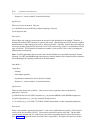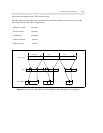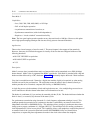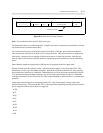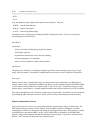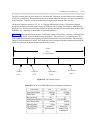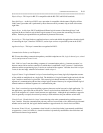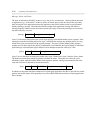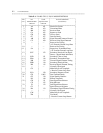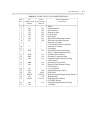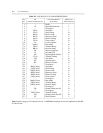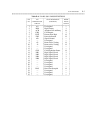COMMUNICATIONS PROTOCOLS D-19
_ ______________________________________________________________________________________
_ ______________________________________________________________________________________
_ ______________________________________________________________________________________
Physical Layer. This layer for BX.25 is compatible with the RS-232C and RS-449 standards.
Data-Link Layer. At this layer, BX.25 uses a procedure is compatible with the HDLC (High-Level Data
Link Control) procedure and is performed by DCIU firmware and by an HDLC chip on each of the DCIUs
eight links.
Packet Layer. At this layer, BX.25 multiplexes different logical streams of data through layer 2 and
regulates the flow of data on each of these logical streams so as to prevent the overrunning of receiver
buffers. Packet layer responsibilities are performed by firmware in the DCIU.
Session Layer. This layer binds two applications into a session and shields the applications from the details
of controlling the layer 3 interface. For BX.25, session layer services are provided by DIP on the 501CC.
Application Layer. This layer is named but not regulated in BX.25.
Communication Pathways and Endpoints
BX.25 terms describing communication pathways and their endpoints are link, logical channel, port, virtual
circuit, and permanent virtual circuit.
Link. Link is a layer 2 term describing a segment of a communication path (e.g., between two DCIU’s or
between a DCIU and an AP line controller) on which there is established a layer 2 protocol. Link includes
whatever entities are performing layer 2 services at each end of the segment. Note that since link is a layer
2 term, it does not imply what kind of hardware is used at layer 1.
Logical Channel. Logical channel is a layer 3 term describing one of many logically independent streams
of data which are multiplexed on a single link. The definition of a logical channel begins and ends with the
layer 3 entities at each end of a given link. This means logical channel numbers are defined on a given
segment of a communication path and that a single logical stream of data may be assigned different logical
channel numbers on different segments of a communication path.
Port. Port is a session layer term describing a gateway between session layer and a single application. To
the application, a port looks like an I/O device. Once a session has been established, it is safe to think of
ports as the endpoints of a virtual circuit between two applications. Although the port numbers at opposite
ends are generally not equal, the session layer entity at each end knows the port numbers at both ends.
Virtual Circuit. Virtual circuit is a layer 3 term referring to the entire communication path between two
layer 3 entities. Since the communication path may consist of several links, with a different logical channel
number used on each link, the logical channel numbers at opposite ends of a virtual circuit can differ.
Permanent Virtual Circuit. A permanent virtual circuit is a virtual circuit that is permanently established,
as opposed to a virtual call which is a virtual circuit that is dynamically established as the need arises and
then released when no longer needed.




